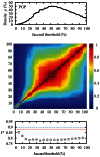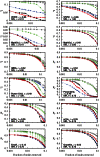Global efficiency of local immunization on complex networks
- PMID: 23842121
- PMCID: PMC3707349
- DOI: 10.1038/srep02171
Global efficiency of local immunization on complex networks
Abstract
Epidemics occur in all shapes and forms: infections propagating in our sparse sexual networks, rumours and diseases spreading through our much denser social interactions, or viruses circulating on the Internet. With the advent of large databases and efficient analysis algorithms, these processes can be better predicted and controlled. In this study, we use different characteristics of network organization to identify the influential spreaders in 17 empirical networks of diverse nature using 2 epidemic models. We find that a judicious choice of local measures, based either on the network's connectivity at a microscopic scale or on its community structure at a mesoscopic scale, compares favorably to global measures, such as betweenness centrality, in terms of efficiency, practicality and robustness. We also develop an analytical framework that highlights a transition in the characteristic scale of different epidemic regimes. This allows to decide which local measure should govern immunization in a given scenario.
Figures








References
-
- Caldarelli G. & Vespignani A. Large Scale Structure and Dynamics of Complex Networks. World Scientific Publishing Company, Singapore (2007).
-
- Keeling M. J. & Rohani P. Modeling Infectious Diseases in Humans and Animals Princeton University Press, Princeton (2008).
-
- Anderson R. M. & May R. M. Infectious Diseases of Humans: Dynamics and Control Oxford University Press, New York (1991).
-
- Pastor-Satorras R. & Vespignani A. Epidemic Spreading in Scale-Free Networks. Phys. Rev. Lett. 86, 3200–3203 (2001). - PubMed
Publication types
MeSH terms
Grants and funding
LinkOut - more resources
Full Text Sources
Other Literature Sources
Medical

